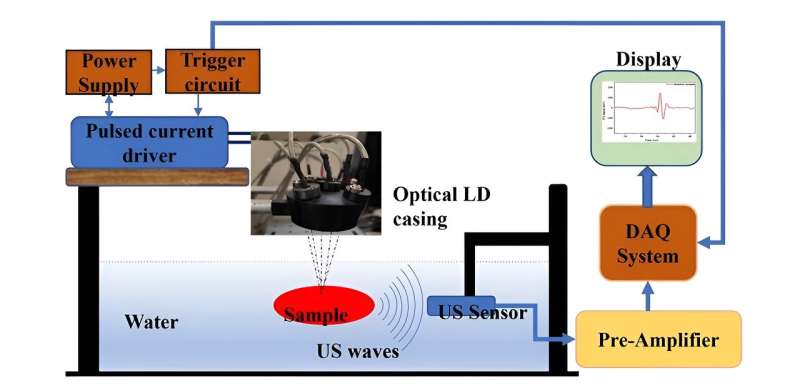This article has been reviewed according to Science X's editorial process and policies. Editors have highlighted the following attributes while ensuring the content's credibility:
fact-checked
peer-reviewed publication
trusted source
proofread
Advancing biomedical diagnostics: Compact photoacoustic sensing instrument for breast tissue characterization

In the realm of biomedical sciences, the quest for accurate and efficient diagnostic tools is ever-evolving. One such promising innovation making waves is the photoacoustic (PA) technique. In the past decade, PA imaging has emerged as a viable imaging modality demonstrated in many clinical applications with promising outcomes. Unlike traditional methods, PA offers a noninvasive approach to probing biological tissues, yet the technique has still been limited in wide clinical applications, partially due to bulky and expensive laser sources.
In a recent study published in the Journal of Biomedical Optics, researchers from the Indian Institute of Technology Indore unveiled a groundbreaking advancement—a compact and cost-effective PA sensing instrument designed specifically for biomedical tissue diagnosis. This proof-of-concept study employs a low-cost diode laser. It represents a crucial step towards bridging the gap between laboratory research and clinical applications.
PA for breast tissue diagnosis
Focusing on the intricate landscape of breast tissue, the study delved into the complexities of fibrocystic changes—a condition often overshadowed by the looming specter of breast cancer. Fibrocystic changes can manifest as breast pain and palpable cystic masses, posing a diagnostic challenge for clinicians. Moreover, these changes are frequently encountered in the peritumoral breast parenchyma, further complicating the diagnostic landscape.
Current diagnostic modalities, such as ultrasound and mammography, though commonly employed, often fall short in providing the accuracy and insight needed for precise diagnosis. Fine needle aspiration cytology, while a staple in diagnostic procedures, is hindered by sampling issues, necessitating further invasive procedures like core needle biopsies or surgical interventions.
Enter the PA technique—a beacon of hope in the realm of diagnostic uncertainty. This innovative approach harnesses the power of laser diodes to probe biological tissues, generating acoustic waves that unveil valuable insights into tissue composition and density. By analyzing the frequency spectra of the PA signals, researchers were able to discern distinct patterns between normal and diseased breast tissues.
Compact and cost-effective PA sensing
The newly developed instrument integrates multiple laser diodes within a compact casing, alongside a custom-built pulsed current supply unit. This setup ensures efficient PA excitation, generating precise 25 nanosecond pulses at a frequency of 20 kHz. Subsequent data analysis involved calculating frequency spectra to quantitatively assess tissue properties.
The results revealed distinct spectral patterns corresponding to different tissue types. For instance, fibrocystic breast disease exhibited a dominant frequency peak around 1.60 MHz, indicative of increased tissue density due to heightened glandular and stromal elements. In contrast, normal breast tissue showcased a lower peak frequency of 0.26 MHz, reflecting its fibrofatty composition.
Furthermore, histopathological examination validated these findings, affirming the correlation between spectral responses and tissue characteristics. Notably, the experimental setup successfully differentiated various tissue types based on quantitative spectral parameters like peak frequency, mean frequency, and spectral energy.
Promise for clinical practice
Crucially, the study underscores the potential of PA technology—not only to enhance diagnostic accuracy but also to streamline the sampling process for pathological breast tissues. With its ability to provide rapid and detailed tissue characterization, the compact PA sensing instrument holds promise for revolutionizing clinical practice.
In essence, this study represents a significant stride towards empowering clinicians with a fast, reliable, and cost-effective tool for diagnosing breast disease. By enabling cost-effective and rapid tissue diagnosis, the compact PA sensing instrument could potentially revolutionize biomedical practices, offering timely interventions and improved patient outcomes.
More information: Suhel Khan et al, Development of a cost-effective compact diode-laser-based photoacoustic sensing instrument for breast tissue diagnosis, Journal of Biomedical Optics (2024). DOI: 10.1117/1.JBO.29.1.017002


















